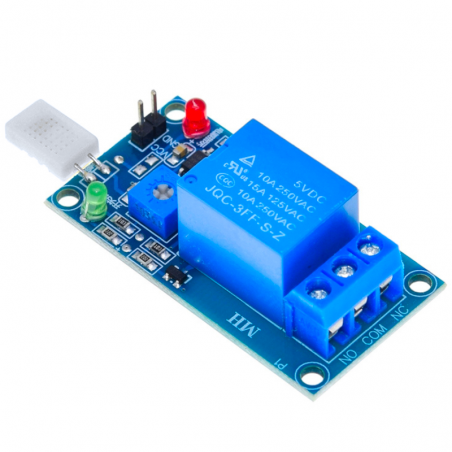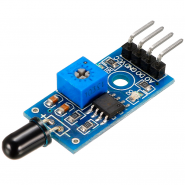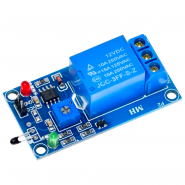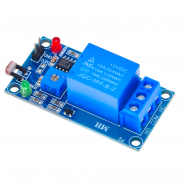- Em promoção!
- -2,00 €





Sensor de humidade com saída a relé.
Através de um potenciómetro consegue definir o valor de humidade e acima desse valor o relé é activado
DESCRIÇÃO EM PORTUGUÊS BREVEMENTE DISPONÍVEL
Se tiver alguma dúvida neste produto não hesite em contactar-nos.
*Atenção: as imagens são meramente ilustrativas.
The Humidity Sensitive Relay Module 5V can automatically control a load such as a fan or misting pump based on the humidity level.
This is a self-contained switching module that energizes / de-energizes a relay based on the humidity level. Just add 5V power and hook up the load you want to control then adjust the potentiometer to set the relative humidity level at which you want the relay to switch between ON / OFF.
This type of module can be used for applications such as to automatically turn on an exhaust fan when the humidity gets above a preset level as might be the case in a green house or aquarium room or it could be used to energize a misting system, such as for orchids, when the humidity drops below a preset level.
The humidity sensor on the module is an HR202.
The humidity level trip-point for triggering the relay can be adjusted using the potentiometer on the module. Turning the pot CW increases the humidity trip-point.
When humidity goes over the trip-point value, an LM393 voltage comparator IC turns on a transistor that energizes the relay coil and it switches ON. A green LED is illuminated when the relay is energized.
When the humidity drops below the preset value, the relay switches back OFF. A flyback diode is included on the module in parallel to the relay coil to safely shunt current when the relay coil is de-energized.
The relay has both NO (Normally Open) and NC (Normally Closed) contacts so the module can either be used to energize a load when humidity goes up past the trip-point value such as an exhaust fan in a greenhouse or when it goes down past that level such as turning on a humidifier to increase the humidity.
The module requires 5V power and ground to operate. There is a red LED that is lit when power is applied to the module. When the relay is energized, the module draws about 80mA from the Vcc pin.
1 x 2 Header (Power Connections)
The output of the relay is rated to switch up to 30VDC at 10A or up to 250VAC at up to 10A (See our notes below about safely switching VDC).
The output is SPDT type with both a NO (Normally Open) terminal and a NC (Normally Closed) terminal relative to the COM terminal. When the relay is de-energized (green LED OFF) the NO-COM is open and the NC-COM is shorted. When the relay is energized (green LED ON) the NO – COM is shorted and the NC-COM is open.
1 x 3 Screw Terminal (Load Connections)
These are nice inexpensive modules that will work for many applications and allow you to control devices based on humidity without the need to have an MCU involved. Just hook up 5V power and your load, fiddle with the adjustment and you are all set.
The adjustment is not an absolute value, rather it is a relative value so it is not possible to adjust it to switch at exactly 60% humidity for instance. It takes a little trial and error to get it to switch at the approximate humidity value where you want it to switch.
We do find the DC rating of the relay to be too aggressive. With DC voltages above about 15V, the contacts can become a little sticky. We recommend using it to switch DC voltages of no more than 15V.
With AC, the relays performed well in our testing switching 120V @ 10A.
To test the device, connect it to power and adjust the pot so that the green LED just goes out. Breathing on the humidity sensor which increases humidity should cause the green LED to come on and an audible click heard from the relay as it switches. After a short while, the relay should switch back off as the humidity falls.
Notes:
| Vcc | Typical | 5V |
| Contact Rating | DC | 15V @ 10A (Tested to 15V @ 6A) |
| 115VAC | 10A | |
| 250VAC | 10A | |
| Module Size | L x W x H (PCB) | 50 x 27 x 18mm (2 x 1.1 x 0 .71″) |
Produtos Associados



Sensor de humidade com saída a relé.
Através de um potenciómetro consegue definir o valor de humidade e acima desse valor o relé é activado
